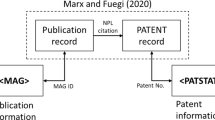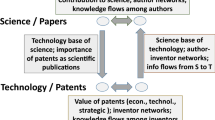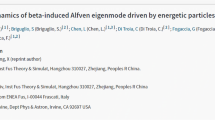Abstract
The interplay and cross-fertilization between science and technology, but also the specific role of science for technological development, have received ample attention in both the research and the policy communities. It is in this context that the concepts of “absorptive capacity” and “knowledge spillovers” play an important role. We operationalize the science-technology link by quantifying and modeling bibliographic references to the scientific literature as they occur in patents. This approach allows exploring the associative patterns between science creation (as emerging from the scientific literature) and technology development (as emerging from the patent literature). In the current paper, we focus on an analysis of the geographic distribution of the science citation patterns in patents, singling out two fields of (different) technological development, namely biotechnology and information technology. In both fields, the science citation flows from the European, Japanese and US science bases into USPTO and EPO-patents are explored and modeled. Intensive geographic citation flows between the regions are identified, pointing (amongst others) to the strength of both the US and the European science bases as sources for technological activity and creativity around the world.
Similar content being viewed by others
References
ALLeN, T. J. (1977), Managing the Flow of Technology, Cambridge, MA: The MIT Press.
ANDeRSEN, B. (2001), Technological Change and the Evolution of Corporate Innovation, Edward Elgar Publishing.
ARROW, K. (1994), The production and distribution of knowledge, In: G. SILVERBERG, L. SOETE (Eds), The Economics of Growth and Technical Change.
BAUMOL, W. (2002), The Free Market Innovation-Machine, Princeton: Princeton University Press.
CASSIMAN, B., R. VEUGELeRS (2002), R&D cooperation and spillovers: some evidence from Belgium, American Economic Review, forthcoming.
COHEN, W. M., D. A. LeVINTHAL (1990), Absorptive capacity: A new perspective on learning and innovation, Administrative Science Quarterly, 35: 128-152.
COLLINS, P., S. WYATT (1988), Citations in patents to the basic research literature, Research Policy, 17: 65-77.
DAVID, P., D. FORAY (1995), Accessing and Expanding the Science and Technology Base, STI Review, pp. 13-68 (OECD, Paris).
DeBACKERE, K., M. A. RAPPA (1995), Institutional variations in problem choice and persistence among scientists, Research Policy, 23 (4): 425-441.
DOSI, G. (2000), Innovation, Organization and Economic Dynamics, Cheltenham: Edward Elgar.
DOSI, G., S. FABIANI (1994), Convergence and divergence in the long-term growth of open economics, In: Silverberg & Soete (Eds).
ERNST & YOUNG (2000), Evolution, Ernst & Young's Seventh Annual European Life Sciences Report, Life Science Group.
ETZKOWITZ, H., L. Leydesdorff (1997), Introduction to special issue on science policy dimensions of the Triple Helix of university-industry-government relations, Science and Public Policy, 24 (1): 2-5.
ETZKOWITZ, H., L. Leydesdorff (1998), The endless transition: A 'Triple Helix' of university industry-government relations, Minerva, 36: 203-208.
ETZKOWITZ, H., L. LeYDeSDORFF (2000), The dynamics of innovation: from national systems and 'Mode 2' to a Triple Helix of university-industry-government relations, Research Policy, 29: 109-123.
EUROPEAN COMMISSION (1997), The Globalising Learning Economy: Implications for Innovation Policy, TSER, DG Science Research and Development, EUR 18307 EN.
EUROPEAN COMMISSION (1999), Knowledge and Learning-Towards a Learning Europe, Futures Report Series 14, Institute for Prospective Technological Studies (IPTS), The Futures Project, EUR 19034 EN.
EUROPEAN COMMISSION (2003), European Innovation Scoreboard 2002.
FREEMAN, C. (1994), The economics of technical change, Cambridge Journal of Economics, 18: 463-514.
GIBBONS, M., C. LIMOGES, H. NOWOTNY, S. SCHWARTZMAN, P. SCOTT, M. TROW (1994), The New Production of Knowledge, Sage, London.
GRILICHES, Z. (1990), Patent statistics as economic indicators: A survey, Journal of Economic Literature, 28: 1661-1707.
GRUPP, H. (1998), Foundations of the Economics of Innovation, Edward Elgar, Cheltenham, UK; Northampton, MA, US.
GRUPP, H., U. SCHMOCH (1992), Perception of scientification of innovation as measured by referencing between patents and papers, In: H. GRUPP (Ed.), Dynamics of Science-based Innovations, Springer Publishers, Berlin/Heidelberg, pp. 73-128.
JAFFE, A. B., M. TRAJTENBERG, M. S. FOGERTY (2000), Knowledge Spillovers and Patent Citations — Evidence from a Survey of Inventors, National Bureau of Economic Research, Cambridge (MA), www.nber.oreg/sloan/jaffe.html
LeYDeSDORFF, L., H. ETZKOWITZ (1996), Emergence of a Triple Helix of university-industry-government relations, Science and Public Policy, 23 (5): 279-286.
LeYDeSDORFF, L., H. ETZKOWITZ (1998), Triple Helix of innovation: introduction, Science and Public Policy, 25 (6): 358-364.
MEYER, M. (2000a), Does science push technology? Patents citing scientific literature, Research Policy, 29 (3): 409-434.
MEYER, M. (2000b), What is special about patent citations? Differences between scientific and patent citations, Scientometrics, 49 (1): 93-123.
MEYER-KRAHMER, F. (2000), Increasing role of Basic Research for Innovation: The Case of Science Based Technologies. Empirical Evidence and Institutional Consequences, ISI Karlsruhe, Conference Paper.
NARIN, F., D. OLIVASTRO (1992), Status report: Linkage between technology and science, Research Policy, 21: 237-330.
NARIN, F., D. OLIVASTRO (1998), Linkage between patents and papers: An interim EPO/US comparison, Scientometrics, 41: 51-59.
NARIN, F., E. NOMA (1985), Is technology becoming science? Scientometrics, 7 (3-6): 369-381.
NARIN, F., K. S. HAMILTON, D. OLIVASTRO (1997), The increasing linkage between US technology and science, Research Policy, 26: 317-330.
NARIN, F., M. ALBERT, P. KROLL, D. HICKS (2000), The Link Between Australian Patenting and Basic Science-Inventing our Future, Report to the Australian Research Council, Canberra.
NELSON, R. R. (1994), What has been the matter with neoclassical growth theory? In: SILVERBERG & SOETE (Eds).
NELSON, R. R., S. G. WINTER (1982), An Evolutionary Theory of Economic Change, Cambridge: Harvard University Press.
OECD (2001), Science, Technology, and Industry Outlook-Drivers of Growth: Information Technology, Innovation and Entrepreneurship, Paris, France.
PAVITT, K. (1984), Sectoral patterns of technical change: towards a taxonomy and a theory, Research Policy, 13: 343-373.
POLT, W., C. RAMMER, D. SCHARTINGNEARIN, H. GASSLeR, A. SCHIBANY (2000), Benchmarking industry-science relations in Europe-The role of framework conditions, Conference on: Benchmarking Europe's Industrial Competitiveness. A benchmarking project on industry-science relations (ISR).
SCHERER, F. M. (1985), Innovation and Growth, Cambridge: The MIT Press.
SCHMOCH, U. (1993), Tracing the knowledge transfer from science to technology as reflected in patent indicators, Scientometrics, 26 (1): 193-211.
SENKER, J. (1993), The contribution of tacit knowledge to innovation, AI & Society, 7: 208-224.
SENKER, J. (1995), Tacit knowledge and models of innovation, Industrial and Corporate Change, 4 (2): 425-447.
SILVERBERG, G., L. SOETE (Eds) (1994), The Economic Growth and Technical Change: Technologies, Nations, Agents, Elgar Aldershot.
SOLOW, R. M. (1997), Learning from 'Learning by Doing' Lessons for Economic Growth, Palo Alto: Stanford University Press.
Van LOOY, B., E. ZIMMERMANN, R. VEUGELeRS, A. VERBEEK, J. MELLO, K, DeBACKERE (2003), Do science-technology interactions pay off when developing technology? An exploratory investigation of 10 science-intensive technology domains, forthcoming in Scientometrics, 57 (3): 355-367.
Van VIANEN, B. G., H. F. MOED, A. F. J. Van RAAN (1990), An exploration of the science base of recent technology, Research Policy, 19: 61-81.
VERBEEK, A., K. DeBACKERE, M. LUWEL, P. ANDRIES, E. ZIMMERMANN, F. DeLeUS (2002a), Linking science to technology: Using bibliographic references in patents to build linkage schemes, Scientometrics, 54 (3): 399-420.
VERBEEK, A., P. ANDRIES, J. CALLAERT, K. DeBACKERE, M. LUWEL, R. VEUGELeRS (2002b), Linking Science to Technology, Bibliographic References in Patents-Science and Technology Interplay: Policy relevant findings and interpretations, European Commission, Brussels, EUR 20492, Vol. 1
Author information
Authors and Affiliations
Corresponding author
Rights and permissions
About this article
Cite this article
Verbeek, A., Debackere, K. & Luwel, M. Science cited in patents: A geographic "flow" analysis of bibliographic citation patterns in patents. Scientometrics 58, 241–263 (2003). https://doi.org/10.1023/A:1026232526034
Issue Date:
DOI: https://doi.org/10.1023/A:1026232526034




